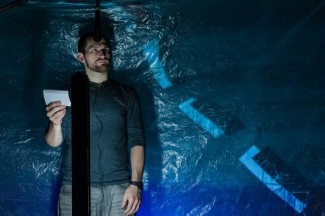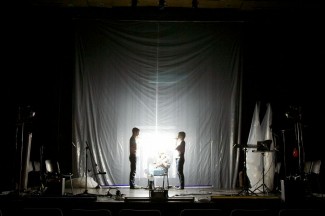INTERVIEW: ‘Juárez: A Documentary Mythology’ investigates US-Mexico border

The so-called “Murder Capital of the World” is ready for its off-Broadway debut, thanks to a daring theater company ready to unleash a year-in-the-making hybrid work on New York City audiences.
In a few days, Theater Mitu is set to premiere Juárez: A Documentary Mythology. The production will play the Rattlestick Playwrights Theater, Jan. 9-19. The piece examines the strange disparity of Juárez, Mexico, which sits south of the Texas border, and its sister city to the north, El Paso, Texas. Separated by a simple bridge, Juárez and El Paso are so close, and yet they can sometimes feel a world away. A Documentary Mythology explores all of these topics, including gang warfare, drug cartels, trade relations and femicide, among other topics.
Recently, Hollywood Soapbox exchanged emails with Theater Mitu artistic director Rubén Polendo, who was born and raised in Juárez. The play is the culmination of years of research and investigating, including interviews with residents of both cities and video footage from the border.
Questions and answers have been edited slightly.
Juárez: A Documentary Mythology has been in the works for a couple of years. Could you describe the reporting and writing phase of this ambitious project?
After the initial contextual research and in-person investigations — during the process of documenting and then creating the actual piece — it became very important to us that the source material for the project not just be factual context; nor should it be only our own imaginings for how this place should be portrayed. It was very important that the main source, the main portrayal, be the voices of the people of those cities. And so as we created a plan, a narrative arc for the piece, it became important to us as a company to be in residence in the community for extended periods of time and engage in conversations, interview, dialogue, with a range of citizens. Varying in age, occupation, political view, social class, etc. And really try to understand, through their eyes, the very complicated situation there. Then the next challenge became investigating how to theatricalize those voices. Collaboratively we decided that rather than inhabiting those personas and stories, we would create a series of visual installations which would support the language. And it’s those installations that form the spine of the piece.

What was your greatest discovery after the research was complete?
The incredible presence of hope in the city (Juárez). From the first day we arrived — when the violence was still near its peak — until recently — as it’s begun to wane — there was always such a belief by the community in the community. They knew as bad as it got, it could get better. As we were told in an interview by one resident of the city very early on, “Please don’t show our city any worse than it is. Or any better. Just show it exactly as it is now.” There was great pride and trust by the citizens of Cd. Juarez and El Paso in what the community had been and would be again.
Because you grew up in Juárez, how does the show have a special meaning or importance?
I created this show along with the company members of Theater Mitu as a way to explore my hometown and its sister city across the border (El Paso). For years I had been hearing stories in the news about the violence, cartels, drug smuggling and other woes that plagued this border community. Most of my family still lives in the area, and though I returned occasionally, I began to feel it was quickly becoming a foreign place to me. So we began traveling to Cd. Juárez/El Paso, meeting with everyone who would sit down and talk to us about this great region. And along the way, we collected some amazing stories. In many ways, those stories have redefined for me — and helped me rediscover — so many great aspects of that place. And it’s created a great bond between the company and the cities — introducing many of them to this new place which now carries a special meaning for them as well.
Can you describe (without giving too much away) what audience members can expect when they sit down for a performance of Juárez: A Documentary Mythology?
Ultimately the piece we’ve created functions as an emotional map of this landscape — this community. It’s an emotional map of a very complicated situation, which interfaces politics, economy, family history, honor, violence, shared mythology and history.
Do you find there’s still hope that the city will become a safer place one day?
Yes, already it’s getting better. From when we first started traveling to the area, we’ve already seen a change. Though there’s still a long ways to go. It’s best said in the words of my father, who’s lived his whole life in Juárez, and told us a story from his youth. … When a home near his burned to the ground. And from the wreckage, his brother picked out the pieces of a large piano. My father, a young mechanic at the time, told his older brother, “I bet you I can put that back together. And if I do, you’ll teach me how to play.” So my father worked for months, rebuilding piece by piece the piano; using whatever materials he could find (including toothpicks). Eventually he finished, and the piano worked. He showed it to his brother, who upon hearing it remarked, “That’s a miracle!” To which my father responded, “No — the miracle will be teaching me how to play.” As he said, after a lot of hard work, the piano played its own kind of music. It looked different, it sounded different … but the sound … the sound was still beautiful.
By John Soltes / Publisher / John@HollywoodSoapbox.com

